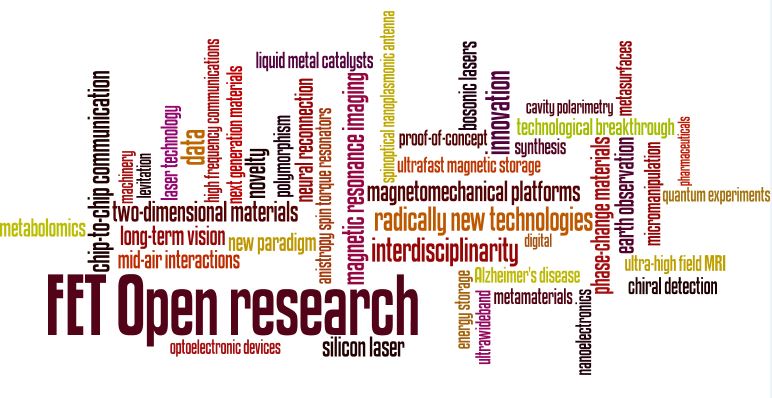25 new FET Open ideas for breakthrough technologies

Related topics
Energy ICT Research & Innovation Innovation International cooperation Funding Researchers SMEs Biotechnology EU countries Non-EU countries FET Opendate: 29/09/2016
FET Open Research and Innovation Actions (RIA)
AMADEUS will investigate next generation materials and solid state devices for ultra-high temperature energy storage and conversion. Coordinator: Universidad Politécnica de Madrid, Spain.
ArrestAD proposes a prototype diagnostic kit for Alzheimer's disease early (decades before the disease onset) detection based on heparan sulfates accumulation in blood samples. Coordinator: Université Paris XII Val-de-Marne, France.
ByAxon focusses on the development of an active bypass that will enable neural reconnection directly at the spinal cord level. Coordinator: Fundación IMDEA Nanociencia, Spain.
ChipScope wants to overcome the diffraction limits of light waves with superresolution lighting on a chip which will advance scientific investigation of living tissue. Coordinator: Universitat de Barcelona, Spain.
DISCOVERER proposes radically new technologies for earth observation platforms at significantly lower altitudes than currently possible. Coordinator: University of Manchester, United Kingdom.
FEMTOTERABYTE intends to develop a new paradigm for ultra-dense and ultrafast magnetic storage: the spinoptical nanoplasmonic antenna operating at the nanometer length-scale. Coordinator: Göteborgs Universitet, Sweden.
HISTO-MRI aims at non-invasive visualization of individual human cells in vivo and in real time through high frequency pulsed magnetic resonance imaging. Coordinator: Agencia Estatal Consejo Superior de Investigaciones Científicas, Spain.
Levitate seeks to create a radically new human-computer interaction paradigm through levitation with localised tactile and audio feedback for mid-air interactions. Coordinator: University of Glasgow, United Kingdom.
LLR wants to improve lightning protection by building a novel lightening rod based on laser technology. Coordinator: Centre National de la Recherche Scientifique, France.
LMCat the proposal wants to revolutionise the production of two-dimensional materials (graphene, hexagonal boron nitride, silicene, etc.) and reach unprecedented quality and production speed by using innovative liquid metal catalysts.Coordinator: Universiteit Leiden, Netherlands.
MagnaPharm envisages radical innovation in pharmaceuticals by controlling polymorphism in pharmaceutical compounds through magnetic fields. Coordinator: University of Bristol, United Kingdom.
MaQSens seeks to establish radically new magnetomechanical platforms for quantum experiments and quantum enabled sensing technologies. Coordinator: Universität Wien, Austria.
M-CUBE intends to go beyond the limits of MRI clinical imaging with a metamaterials antenna for ultra-high field MRI. This will offer a much better insight in the human body and enable earlier detection of diseases. Coordinator: Université d'Aix Marseille, France.
MIR-BOSE intends to realize innovative mid- and far-IR optoelectronic devices based on Bose-Einstein condensation. These novel bosonic lasers promise temperature independent operation and high powers. Coordinator: Université Paris-Sud, France.
One-Flow's vision is an end-to-end sustainable process design for pharmaceuticals. This will be achieved by a self-organising flow reactor system based on compartmentalized green-solvent digital synthesis machinery. Coordinator: Technische Universiteit Eindhoven, Netherlands.
PHASE-CHANGE SWITCH targets energy efficient applications beyond CMOS and high frequency communications through novel phase-change materials and switches. Coordinator: École Polytechnique Fédérale de Lausanne, Switzerland.
SiLAS aims at the development of a silicon-based laser, which would revolutionize the electronics industry by adding intra-chip and chip-to-chip communication at the speed of light. Coordinator: Technische Universiteit Eindhoven, Netherlands.
SUMCASTEC explores a radically new approach for isolating and neutralizing cancer stem cells through semiconductor-based ultrawideband micromanipulation. Coordinator: Université de Limoges, France.
TISuMR suggests a novel approach towards a systemic understanding of liver function and disease based on integrated tissue slice culture and nuclear magnetic resonance metabolomics. Coordinator: University of Southampton, United Kingdom.
TRANSPIRE envisages the high-speed transfer of vast amounts of data through terahertz radio communication based on anistropy spin torque resonators. Coordinator: Trinity College Dublin, Ireland.
ULTRACHIRAL wants to enable ultrasensitive chiral detection by signal-reversing cavity polarimetry with applications ranging from medical diagnostics to atmospheric studies. Coordinator: Foundation for Research and Technology Hellas, Greece.
VISORSURF proposes a novel hardware platform for software-driven functional metasurfaces with enormous potential for the realisation of materials with specific electromagnetic behaviour. Coordinator: Foundation for Research and Technology Hellas, Greece.
FET Open Coordination and Support Actions (CSA)
CARBOMET will foster collaboration, cross-fertilisation and communication in the field of carbohydrates. The aim is to facilitate a uniform approach to the metrology of carbohydrates which will have a significant impact in bioindustries. Coordinator: University of Manchester, United Kingdom.
EFFECT intends to enhance visibility and impact of FET research and to stimulate debate and collaboration among multiple actors. Coordinator: YOURIS.COM, Belgium.
NANOARCHITECTRONICS aims at establishing a new interdisciplinary research area at the crossroad of electromagnetics and nanoelectronics. Coordinator: Università degli Studi di Siena, Italy.
FET-Open call statistics* for the 1st cut-off 2016/17:
RIA: 22 / 544 (4%)
CSA: 3 / 10 (30%)
Of note, number of proposals below threshold: 272 (RIA) and 4 (CSA).
(*) Number of proposals retained for grant agreement preparation / Number of eligible proposals
More information:
Funded projects from the first, second and third cut-off 2014/2015.
